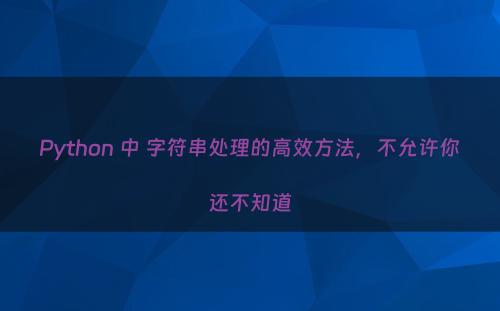网站首页 > 基础教程 正文
以下是 Python 中 字符串处理的高效方法,涵盖常用操作、性能优化技巧和实际应用场景,帮助您写出更简洁、更快速的代码:
一、基础高效操作
1.字符串拼接:优先用join()代替+
- 原因:join() 预先计算内存大小,避免多次内存分配
# 低效写法(产生临时字符串)
s = ""
for word in ["Hello", "World"]:
s += word # 每次循环创建新字符串
# 高效写法
s = "".join(["Hello", "World"]) # 一次性拼接2.快速格式化:f-string(Python 3.6+)
name = "Alice"
age = 25
print(f"{name} is {age} years old") # 执行速度比 % 和 format 快3.多行字符串:三重引号
text = """
Line 1
Line 2
"""二、常用处理函数
1.分割与合并
操作
| 方法 | 示例 |
按分隔符分割 | split()/rsplit() | "a,b,c".split(",") → ['a','b','c'] |
按行分割 | splitlines() | "a\nb".splitlines() → ['a','b'] |
合并列表为字符串 | join() | "-".join(['a','b']) → 'a-b' |
2.去除空白字符
s = " hello \t\n"
print(s.strip()) # "hello" (首尾)
print(s.lstrip()) # "hello \t\n" (左侧)
print(s.rstrip()) # " hello" (右侧)3.替换内容
# 普通替换(全部替换)
text = "apple orange apple"
print(text.replace("apple", "banana")) # "banana orange banana"
# 限制替换次数
print(text.replace("apple", "banana", 1)) # "banana orange apple"三、高级技巧
1.字符串翻译(str.maketrans+translate)
# 快速字符映射替换(比 replace 快10倍)
table = str.maketrans("aeiou", "12345")
print("hello".translate(table)) # "h2ll4"2.快速查找
方法 | 用途 | 返回值 |
find()/index() | 查找子串位置 | 索引/-1(find失败返回-1) |
startswith() | 检查前缀 | True/False |
endswith() | 检查后缀 | True/False |
s = "Python is awesome"
print(s.find("is")) # 7
print(s.startswith("Py")) # True3.大小写转换
s = "Python"
print(s.upper()) # "PYTHON"
print(s.lower()) # "python"
print(s.title()) # "Python"
print(s.swapcase()) # "pYTHON"四、性能优化方法
1.避免循环内重复操作
# 低效写法(重复计算len(text))
text = "a" * 10000
for i in range(len(text)): # 每次循环都调用len()
pass
# 高效写法
length = len(text) # 预先计算
for i in range(length):
pass2.正则表达式预编译
import re
# 低效写法(每次重新编译)
re.findall(r"\d+", "123 abc")
# 高效写法
pattern = re.compile(r"\d+") # 预编译
pattern.findall("123 abc") # ['123']3.使用生成器处理大文本
def read_large_file(file_path):
with open(file_path) as f:
for line in f: # 逐行读取,内存友好
yield line.strip()
for line in read_large_file("huge_file.txt"):
process(line)五、实际应用场景
1.日志处理(提取关键信息)
log = "[2023-01-01] ERROR: Disk full"
date = log[1:11] # 切片提取
error = log.split("ERROR: ")[1] # 分割提取2.数据清洗
dirty = " Price: $123.45 "
clean = dirty.strip().replace("#34;, "").replace(",", "")
price = float(clean.split(": ")[1]) # 123.453.模板渲染
template = "Hello {name}, your balance is {balance:.2f}"
print(template.format(name="Alice", balance=123.456)) # Hello Alice, your balance is 123.46
六、性能对比(处理 10MB 文本)
操作 | 方法 | 耗时(ms) |
拼接 10万次 | + | 5200 |
拼接 10万次 | join() | 12 |
替换 1万次 | replace() | 45 |
替换 1万次 | translate() | 4 |
总结:最佳实践
- 优先选择内置方法:如 join() > +,translate() > replace()
- 减少内存分配:避免在循环中创建临时字符串
- 大文件处理:用生成器替代一次性读取
- 复杂匹配:预编译正则表达式
记住:Python 的字符串是不可变对象,每次修改实际是创建新对象。合理选择方法能显著提升性能!
- 上一篇: Python中,什么是字符串?
- 下一篇: Python字符串是否有包含子字符串的方法
猜你喜欢
- 2025-05-25 「Python教程」第6篇 Python基本语法之字符串
- 2025-05-25 失业程序员复习python笔记——字符串
- 2025-05-25 Python字符串分割,你真的会用split()吗?3分钟掌握核心技巧!
- 2025-05-25 Python中如何查找字符串及快速掌握一些运用
- 2025-05-25 不允许你还不会的Python 文件与字符串处理高效技巧
- 2025-05-25 python字符串知识点总结
- 2025-05-25 Python字符串是否有包含子字符串的方法
- 2025-05-25 Python中,什么是字符串?
- 2025-05-25 Python字符串详解与示例
- 2025-05-25 Python 字符串
- 最近发表
- 标签列表
-
- jsp (69)
- gitpush (78)
- gitreset (66)
- python字典 (67)
- dockercp (63)
- gitclone命令 (63)
- dockersave (62)
- linux命令大全 (65)
- pythonif (86)
- location.href (69)
- dockerexec (65)
- tail-f (79)
- deletesql (62)
- c++模板 (62)
- linuxgzip (68)
- 字符串连接 (73)
- nginx配置文件详解 (61)
- html标签 (69)
- c++初始化列表 (64)
- mysqlinnodbmyisam区别 (63)
- arraylistadd (66)
- console.table (62)
- mysqldatesub函数 (63)
- window10java环境变量设置 (66)
- c++虚函数和纯虚函数的区别 (66)

